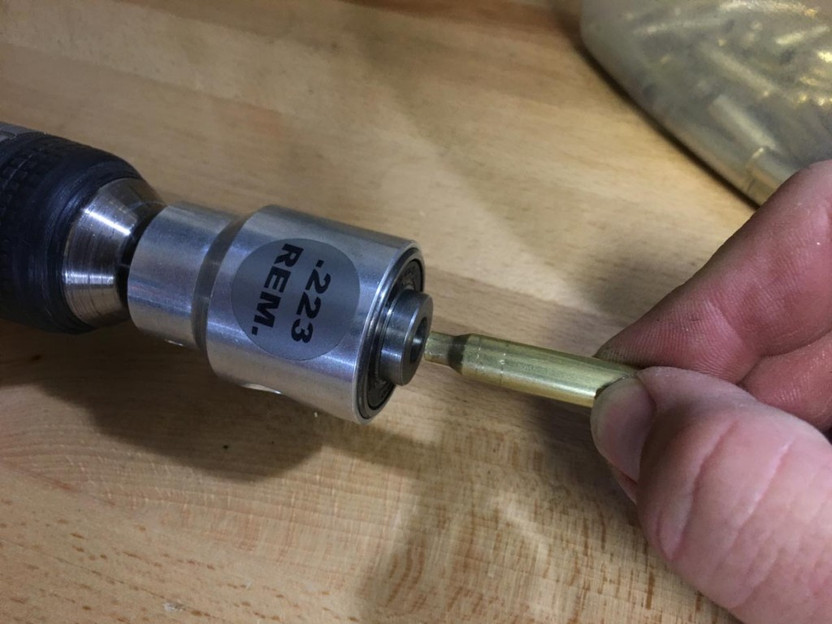Rifle Case Trimming
Posted by Matt Wright on 19th Sep 2025
The Essential Guide to Case Trimming: Why Your Rifle Brass Needs a Haircut
Pistol vs. Rifle Cases: Why Trimming Matters for Precision
If you exclusively shoot a pistol, you can breathe a sigh of relief. Straight-walled handgun cartridges—like the ubiquitous .45 ACP rarely, if ever, require trimming. The stress on the case during firing is relatively low, meaning case growth is minimal.
However, rifle cartridges are an entirely different story.
The Science of Case Growth: Why Your Brass Stretches
When a rifle cartridge fires, the extreme pressure causes the casing to:
-
Expand Radially: The walls of the brass momentarily press out against the rifle chamber.
-
Relax and Contract: The case shrinks back down, but it doesn't quite return to its original diameter.
During the reloading process, specifically when using a full-length resizing die, the brass is forced back into specification. The resizing die performs three key functions:
-
Resets the case body diameter to its nominal dimension.
-
Pushes the shoulder back to the correct rim-to-shoulder dimension (headspace).
-
Resets and slightly flares the neck to accept a new bullet.
The "extra" metal that was stretched during firing has nowhere to go but forward. This causes the case neck to get longer with each firing cycle. After a few uses, the overall case length can exceed the maximum allowable dimension, leading to potential safety and accuracy issues.
The Solution: Case Trimming for Optimal Cartridge Length
Trimming is the simple, necessary step of cutting the case neck back down to its proper, nominal length.
Pro Tip: To find the precise length you need, always check your reloading manual. It will provide the exact “trim-to” length, allowing you to cut with confidence.
How to Choose the Best Case Trimmer for Your Needs
The best case trimming setup for you depends on three main factors: your anticipated volume of work, your required precision, and your patience level.
| Trimmer Type | Initial Cost | Production Speed | Ideal User |
| Handheld/Manual | Low | Slow | Low-volume shooter, beginner, maximum budget constraint. |
| Crank/Lathe Style | Moderate | Medium | Medium-volume shooter, precision-focused handloader. |
| Powered/Motorized | High | Fast | High-volume shooter, competitive or production handloader. |
You can either spend more money upfront for equipment that provides more automation and production per hour, or you can opt for a slower, lower-cost manual approach.
The Essential Post-Trimming Steps: Chamfering and Deburring
The trimming operation often leaves a rough, flat cut that can shave copper off a seated bullet or prevent smooth chambering. This makes chamfering and deburring indispensable:
-
Chamfering: Applies a slight bevel to the inside of the case mouth. This allows the new bullet to seat smoothly and evenly without deformation.
-
Deburring: Removes the rough edges from the outside of the case mouth, often applying a slight outer bevel to aid in chambering.
The Indispensable Tool: Using a Case Gauge
Before you finalize your trimming process, you need a way to verify your work. A case gauge is an indispensable tool, especially for bottleneck rifle cartridges.
This gauge is a metal block that replicates the inside dimensions of a perfectly-sized chamber for your specific caliber.
-
Verifying Resizing: Simply dropping your case into the gauge will tell you if your full-length resizing die is set correctly (checking the critical headspace dimension).
-
Checking Case Length: It's a quick visual way to check if your cases are excessively long or short.
For the most insightful feedback, consider investing in Slotted Case Gauges. Though more expensive, the slot allows you to see exactly how your cartridge case conforms to the ideal chamber, giving you unparalleled insight into your sizing and trimming consistency.
Hate Trimming? Try Fully Processed Rifle Brass
If the idea of measuring and cutting thousands of cases sounds exhausting, there is a shortcut. Fully processed brass has already been cleaned, resized, and trimmed to length. You can skip this entire step and go straight to priming.
The Reward: Increased Accuracy and Case Life
While case trimming adds a meticulous step to your reloading routine, the benefits are significant:
-
Increased Case Life: Proper trimming and resizing prevent over-stressing the brass, allowing for more uses per casing.
-
Enhanced Accuracy: An optimum overall case length is crucial for consistent neck tension and bullet seating, which translates directly to tighter groups downrange.
With the right trimmer setup, you don't need to be a metalworking specialist. Most modern tools allow you to preset the length and operate with high, consistent precision, ensuring perfect, repeatable results every time.
Would you like me to focus on a specific section, such as the comparison table or the detailed steps, to further refine the keywords for a particular audience?

